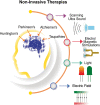Invasive and non-invasive therapies for Alzheimer's disease and other amyloidosis
- PMID: 32930962
- PMCID: PMC7575678
- DOI: 10.1007/s12551-020-00752-y
Invasive and non-invasive therapies for Alzheimer's disease and other amyloidosis
Abstract
Advancements in medical science have facilitated in extending human lives. The increased life expectancy, though, has come at a cost. The cases of an aging population suffering from degenerative diseases like Alzheimer's disease (AD) are presently at its all-time high. Amyloidosis disorders such as AD are triggered by an abnormal transition of soluble proteins into their highly ordered aggregated forms. The landscape of amyloidosis treatment remains unchanged, and there is no cure for such disorders. However, an increased understanding of the mechanism of amyloid self-assembly has given hope for a possible therapeutic solution. In this review, we will discuss the current state of molecular and non-molecular options for therapeutic intervention of amyloidosis. We highlight the efficacy of non-invasive physical therapies as possible alternatives to their molecular counterparts. Graphical abstract.
Keywords: Aggregation; Amyloid-beta; Non-invasive therapies; Protein folding; Protein misfolding diseases; Tau.
Conflict of interest statement
The authors declare that they have no conflict of interests.
Figures







References
-
- Andreadou I, et al. The olive constituent oleuropein exhibits anti-ischemic, antioxidative, and hypolipidemic effects in anesthetized rabbits. J Nutr. 2006;136:2213–2219. - PubMed
-
- Aprile FA, Sormanni P, Vendruscolo M. A rational design strategy for the selective activity enhancement of a molecular chaperone toward a target substrate. Biochemistry. 2015;54:5103–5112. - PubMed
-
- Baumketner A. Electric field as a disaggregating agent for amyloid fibrils. J Phys Chem B. 2014;118:14578–14589. - PubMed
Publication types
Grants and funding
LinkOut - more resources
Full Text Sources

